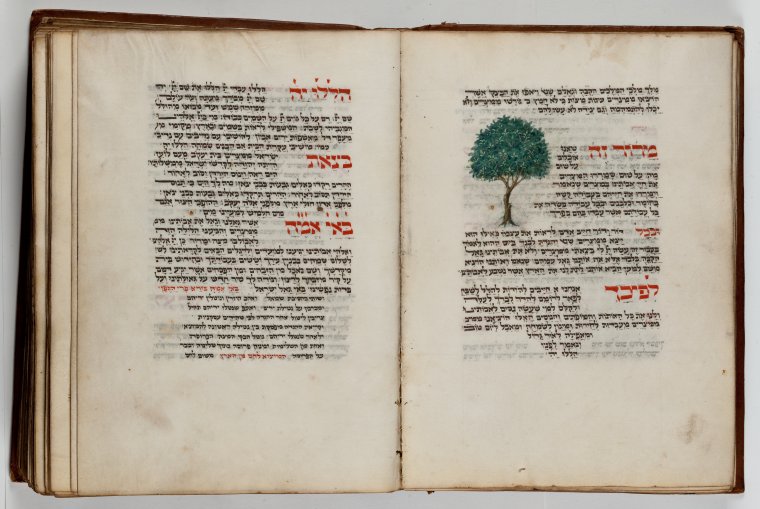llluminated Haggadot Online: A Global Journey

“And you shall explain to your child on that day …..” (Exodus 13:8)
The Passover evening celebration—the Seder (order)—fulfills the biblical command to recount the story of yetsi’at Mitzrayim, the exodus from ancient Egypt. The biblical text tells of the arrival of the Bene-Yisrael (children of Israel) in ancient Egypt to escape famine, their descent into slavery and their miraculous liberation. At God’s behest, Moses demands that Pharoah release the slaves. After each refusal, a plague descends upon the land. Finally, Pharoah agrees to let the slaves travel into the wilderness. On the night of the final plague, the ancient Israelites prepare for their departure. Gathering in their homes, dressed for the journey, they hurriedly eat roasted lamb with unleavened bread and bitter herbs.
The celebration’s narrative (haggadah) is structured around a fixed order of rituals and symbols which dramatize the movement of the ancient Israelites from slavery to freedom. The seder table is set with unleavened bread (matzah, the bread of affliction), bitter herbs (horseradish or romaine lettuce) and a green vegetable (for spring) to be dipped in saltwater (tears of the slaves). Four cups of wine for each participant reflect four promises of redemption. A shankbone represents the lamb sacrifice; a roasted egg, the festival offering.
Every ritual and symbol should prompt a child at the table to ask "Why is this night different?".
This year the Library will be unable to display pages from the magnificent Rose family seder books. But, from our Digital Collections and from around the world we can still experience the beauty of illustrated haggadot.
The library's digital collections provide access to the manuscript of the Hamburg Haggadah and to the Don Ferrante Mahzor which includes the Passover haggadah.
Among the Passover highlights on the British Library's website are the digitized manuscripts of the Brother Haggadah, the Golden Haggadah and the Ashkenazi Haggadah.
The Birds Head Haggadah is held at the Israel Museum and the famous Sarajevo haggadah at the National Museum of Bosnia and Herzegovina.
The desire to illuminate this ubiquitous liturgy is still alive and well. The Polish artist Arthur Szyck drew and published his haggadah during the dark days of the 1930's.
Avner Moriah, an Israeli artist, has also created an illustrated haggadah, Hagadat Moriyah
The Morgan library not only digitized the Rose Haggadah, illustrated by the contemporary artist Barbara Wolff, but has included a film documenting its creation and has mounted an online exhibition focused on her work.
The haggadah does not tell a tale tied merely to one event. Rather, it provides a paradigm, not only for the journey of the Jewish people, but for the experience of humanity. In the words of Rabbi Lord Jonathan Sacks “No story has had a greater influence in inspiring revolution or evolution toward a just and humane society. It is the West’s great meta-narrative of liberty” (The Jonathan Sacks Haggada).
Read E-Books with SimplyE
 With your library card, it's easier than ever to choose from more than 300,000 e-books on SimplyE, The New York Public Library's free e-reader app. Gain access to digital resources for all ages, including e-books, audiobooks, databases, and more.
With your library card, it's easier than ever to choose from more than 300,000 e-books on SimplyE, The New York Public Library's free e-reader app. Gain access to digital resources for all ages, including e-books, audiobooks, databases, and more.
If you don’t have an NYPL library card, New York State residents can apply for a digital card online or through SimplyE (available on the App Store or Google Play).
Need more help? Read our guide to using SimplyE.
![Seder Hagadah shel Pesah, [Title page]](https://images.nypl.org/index.php?id=1244021&t=w)